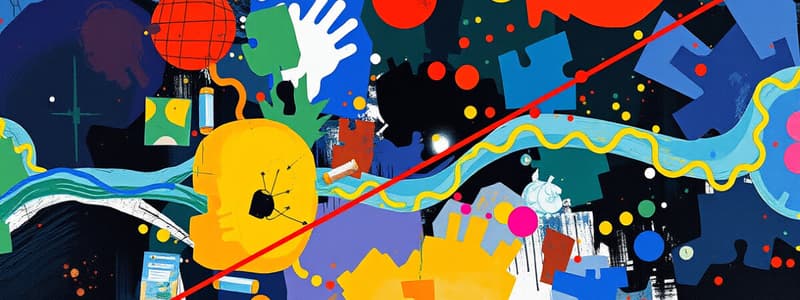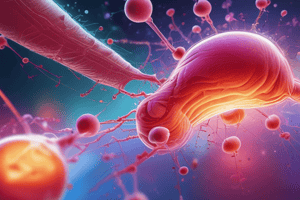Podcast
Questions and Answers
What does a rectangular hyperbola in a graph of drug concentration vs proportion of receptors occupied indicate about drug binding?
What does a rectangular hyperbola in a graph of drug concentration vs proportion of receptors occupied indicate about drug binding?
- The binding is characterized by saturation. (correct)
- The drug irreversibly binds to the receptors.
- Binding occurs only at low concentrations of drug.
- There is a linear relationship between drug concentration and receptor occupancy.
How is the affinity of a drug quantified in terms of its receptor binding?
How is the affinity of a drug quantified in terms of its receptor binding?
- By the molar concentration necessary to occupy 50% of the receptors. (correct)
- As the concentration at which the drug occupies 25% of the receptors.
- By the maximum concentration of drug needed to achieve 100% receptor occupancy.
- As the constant that determines the rate of the forward reaction.
What does a low KD value indicate about a drug's interaction with its receptor?
What does a low KD value indicate about a drug's interaction with its receptor?
- The drug stays bound to the receptor for a relatively short time.
- There is a large amount of unbound receptor available.
- The drug has a low likelihood of binding to the receptor.
- The drug has a high affinity for the receptor. (correct)
In the equation KD = k-1/k+1, what do k+1 and k-1 represent?
In the equation KD = k-1/k+1, what do k+1 and k-1 represent?
What phenomenon occurs as a result of receptors being continually bombarded by various chemicals?
What phenomenon occurs as a result of receptors being continually bombarded by various chemicals?
Which of the following statements about the sigmoid plot of drug concentration vs proportion of receptors occupied is true?
Which of the following statements about the sigmoid plot of drug concentration vs proportion of receptors occupied is true?
What is implied by a drug having a high affinity for its receptor?
What is implied by a drug having a high affinity for its receptor?
Which factor does the equilibrium dissociation constant (KD) NOT depend on?
Which factor does the equilibrium dissociation constant (KD) NOT depend on?
What does Emax represent in the context of a concentration-response curve?
What does Emax represent in the context of a concentration-response curve?
Which of the following terms describes the strength of the interaction between a drug and its receptor?
Which of the following terms describes the strength of the interaction between a drug and its receptor?
In pharmacology, what distinguishes full agonists from partial agonists?
In pharmacology, what distinguishes full agonists from partial agonists?
What is the effect of a reversible competitive antagonist on the log-concentration response curve for an agonist?
What is the effect of a reversible competitive antagonist on the log-concentration response curve for an agonist?
Which of the following describes the term KD in drug-receptor interactions?
Which of the following describes the term KD in drug-receptor interactions?
Which of the following statements about specificity in drug-receptor interactions is true?
Which of the following statements about specificity in drug-receptor interactions is true?
What does the term EC50 indicate in pharmacological studies?
What does the term EC50 indicate in pharmacological studies?
How is efficacy defined in the context of drug-receptor interactions?
How is efficacy defined in the context of drug-receptor interactions?
What does the EC50 represent in pharmacology?
What does the EC50 represent in pharmacology?
Which function is NOT performed by receptors?
Which function is NOT performed by receptors?
Why are receptors considered highly specific?
Why are receptors considered highly specific?
How does the design of targeted drugs benefit clinical use?
How does the design of targeted drugs benefit clinical use?
What is the significance of the log scale in the representation of drug concentration?
What is the significance of the log scale in the representation of drug concentration?
What role does nicotine play regarding nicotinic acetylcholine receptors?
What role does nicotine play regarding nicotinic acetylcholine receptors?
What characterizes the shift in the agonist log concentration-response curve produced by irreversible competitive antagonists?
What characterizes the shift in the agonist log concentration-response curve produced by irreversible competitive antagonists?
Which term describes the ability of a drug to bind to a receptor, initiating a biological response?
Which term describes the ability of a drug to bind to a receptor, initiating a biological response?
Which statement best describes the nature of full agonists compared to partial agonists?
Which statement best describes the nature of full agonists compared to partial agonists?
What does the term 'KD' refer to in the context of drug-receptor interactions?
What does the term 'KD' refer to in the context of drug-receptor interactions?
How does a reversible competitive antagonist affect the log concentration-response curve for an agonist?
How does a reversible competitive antagonist affect the log concentration-response curve for an agonist?
What is the significance of the term 'pA2' in pharmacology?
What is the significance of the term 'pA2' in pharmacology?
Which of the following terms describes how selectively a drug interacts with its target receptor compared to other receptors?
Which of the following terms describes how selectively a drug interacts with its target receptor compared to other receptors?
What is the relationship between agonist concentration and response in the presence of irreversible competitive antagonists?
What is the relationship between agonist concentration and response in the presence of irreversible competitive antagonists?
What characterizes a drug that has both affinity and efficacy at receptors?
What characterizes a drug that has both affinity and efficacy at receptors?
What distinguishes affinity from efficacy in pharmacology?
What distinguishes affinity from efficacy in pharmacology?
What term is used to describe drugs with low efficacy?
What term is used to describe drugs with low efficacy?
Is the EC50 for an agonist drug always equivalent to its KD? If not, what explains any potential differences?
Is the EC50 for an agonist drug always equivalent to its KD? If not, what explains any potential differences?
What distinguishes competitive antagonists from non-competitive antagonists?
What distinguishes competitive antagonists from non-competitive antagonists?
Which of the following describes the mechanism of reversible competitive antagonists?
Which of the following describes the mechanism of reversible competitive antagonists?
Flashcards are hidden until you start studying
Study Notes
Concentration-Response Relationship
- Drug effects are quantified by the relationship between drug concentration (or dose) and the response produced, represented by concentration-response curves.
- Typical shapes of concentration-response curves are rectangular hyperbolas and sigmoids.
- Emax represents the maximum response a drug can produce (e.g., increase in heart rate to 70 bpm).
- EC50 refers to the drug concentration that yields 50% of the maximum response, indicating drug potency.
Role and Nature of Receptors
- Receptors are protein macromolecules embedded in the cell's lipid bilayer, integral to cell signaling.
- Key functions include detecting extracellular molecules and transducing signals to alter cell activity.
- Receptors exhibit high specificity, linking tightly only with particular molecules like hormones and neurotransmitters.
Affinity, KD, and Drug Binding
- Affinity is defined as the molar concentration of drug required to occupy 50% of the receptors at equilibrium, symbolized as KD.
- High-affinity drugs have low KD values, indicating they associate strongly with their receptors.
- KD provides insight into the likelihood of drug-receptor binding, characterized by the rates of forward (k+1) and backward (k-1) reactions.
Agonists and Antagonists
- Full agonists activate receptors with high efficacy, while partial agonists activate with lesser efficacy.
- Competitive antagonists bind to the same receptor site as agonists but do not activate it, possessing affinity but zero efficacy; reversible antagonists can be outcompeted by increasing agonist concentration.
- Irreversible antagonists cause a non-parallel shift in the concentration-response curve that cannot be overcome by additional agonist doses.
Important Terms
- KD (equilibrium dissociation constant) reflects how tightly a drug binds to its receptor.
- pA2 represents the negative logarithm of the antagonist concentration that reduces the agonist effect to half.
- EC50 quantifies drug potency and response in pharmacological studies.
Applications in Pharmacology
- Understanding drug-receptor interactions is critical for designing selective drugs that minimize side effects.
- Specific drugs designed to bind to particular receptor subtypes lead to targeted therapeutic effects while reducing adverse reactions.
Studying That Suits You
Use AI to generate personalized quizzes and flashcards to suit your learning preferences.




